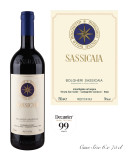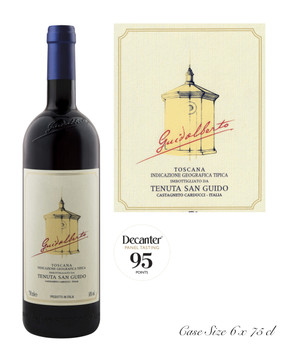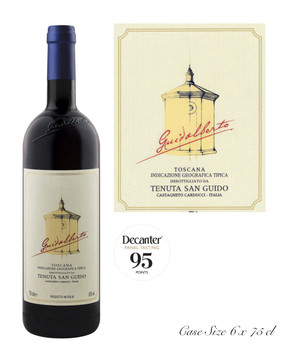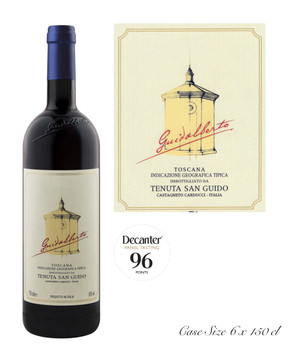
Tenuta San Guido Sassicaia 2021.
Sassicaia means “the place of many stones,” and refers to the region’s gravel soil. All the vineyards located in different altitudes and exposures benefit from extensive sun and maritime breezes. Grapes are handpicked, destemmed and crushed before fermenting with natural yeasts in temperature-controlled stainless steel tanks. The wine is aged in French oak barriques, then refined in bottle before release. Sassicaia’s success prompted the Italian government to grant the wine its own appellation, Bolgheri Sassicaia DOC, beginning with the 1994 vintage.
TYPE OF SOILS: the plots of land that suitable to produce this wine are included in the territorial delimitation of the Doc Bolgheri Sassicaia and entirely comprised within the boundaries of Tenuta San Guido. They show different and composite morphological characteristics, with the presence of limestone areas rich in marl, as well as stones and pebbles (from which the wine takes its name) and partially clay. The vineyards are located at an average altitude between 100 and 300 meters above sea level, with exposure to the West / South-West.
CLIMATIC TREND AND CHARACTERISTICS OF THE VINTAGE: The 2021 was a beautiful vintage. The autumn kicked-off with mild temperatures and sporadic rain. But already from the end of October, temperatures dropped below the seasonal norm with night-time lows reaching the hillside vineyards with around -3/-4°C and frequent rains of good intensity. From mid-December, temperatures rose above normal but by the first ten days of January, it was cold again. The winter of 2020/2021 was particularly rainy and cold. Around mid-February, the polar cold of "Burian" brought freezing temperatures both at night (peaks between -5 and -7°C) and during the day (max 7-10°C). A positive condition for the vines but also for the underground water reserve which benefited from the abundant rains of autumn and winter. From the end of February, temperatures rose for some days above the seasonal norm.
March was dry and generally sunny, with cold temperatures especially in the first week, when northerly winds caused night temperatures to drop close to 0°C. April started with mild temperatures, as if the spring had finally arrived but, from mid-month, temperatures dropped again, approaching 0°C. The consequence was bud thinning in early vines such as Merlot, but also Cabernet Franc. Throughout the month of April and a good part of the month of May, sun and rain kept on alternating, with some sporadic storms, fresh air, and temperatures below the seasonal norm, especially in the early hours of the morning and at night. The vegetative state of the plants was not too much affected, but rather slowed down due to the lower temperatures. Since the end of May, temperatures substantially rose and summer begun. Between May and June, temperatures went above the seasonal norm with dry heat, a situation that persisted until the second half of July. On July 13th, some bad weather led to a drop in temperatures, but no rain. Generally, the plants showed no signs of stress despite the intensity of the heat. To limit the heat impact on the leaves and bunches we used kaolin which gave satisfactory results. Since mid-August, with the movement of the African anticyclone, temperatures returned to normal and, especially at night, even slightly below the seasonal average.
The plants were not affected by the heat of the summer months and the development of the vegetation was regular although with smaller bunches and berries, which resulted in lower production. Thanks to the excellent climatic trend that influenced the pre- and post-harvest period, the maturity of the grapes was in perfect balance between technical maturity and phenolic maturity. Very healthy grapes with excellent maturity and lignification of the seed and stem. The perfect weather conditions allowed the harvest to be carried out in complete tranquillity and to push for longer macerations also based on the health of the grapes.
The fermentations took place regularly with pH and acidity in perfect balance and a marked aroma of the musts.
Slightly higher alcohol content due to a greater sugar concentration of the grapes but great benefit given by excellent freshness and flavour of the musts.
HARVEST PERIOD: the harvesting of the grapes, carried out rigorously by hand, began in the first days of September with the grapes from the youngest vineyards and more precocious vines. It then continued with the Cabernet Sauvignon from the vineyards located at lower altitudes, followed by the vineyards located higher up on the hills, over 300 meters above sea level (Vigna di Castiglioncello and Vigna del Quercione). The harvesting period ended in the first week of October.
VINIFICATION NOTES: Careful selection of the grapes carried out on a sorting table, to eliminate any impurities or imperfections of the grapes. Very soft pressing to avoid breaking the grapes and delicate destemming to avoid the release of improper tannins. Alcoholic fermentation (activated only with our own appropriately selected natural yeasts) concluded in the first week of November and took place regularly with controlled temperatures not exceeding 28-29 °C. A few délestage operations and pumping over facilitated an excellent extraction in terms of polyphenols but also with a large aromatic component and good freshness of the musts. Spontaneous malolactic fermentation took place in steel and concluded in the first days of December. Already from the first week of December 2021, after appropriate decanting of the musts, the wine was placed in oak barriques.
AGING: At the end of the malolactic fermentation, the wine was placed in barriques initially using only 2nd and 3rd passage, until the end of February. During this period, frequent bâtonnages and the addition of noble lees were carried out. From 1 March 2022, the wine was transferred to approximately 40% new wood, 40% first passage and 20% second passage barriques. We used French oak, Tronçais, Allier and Jupilles in particular, with extra-fine grain, light toasting, and long seasoning.
Sassicaia 2021 underwent a 24-month aging period in wood and was subsequently decanted into steel tanks for the final mass selection phase. Before blending, light clarification and oxygenation of the musts. Bottling started in mid-January 2024. Subsequent refinement in the bottle before release on the market.
Sassicaia means “the place of many stones,” and refers to the region’s gravel soil. All the vineyards located in different altitudes and exposures benefit from extensive sun and maritime breezes. Grapes are handpicked, destemmed and crushed before fermenting with natural yeasts in temperature-controlled stainless steel tanks. The wine is aged in French oak barriques, then refined in bottle before release. Sassicaia’s success prompted the Italian government to grant the wine its own appellation, Bolgheri Sassicaia DOC, beginning with the 1994 vintage.
TYPE OF SOILS: the plots of land that suitable to produce this wine are included in the territorial delimitation of the Doc Bolgheri Sassicaia and entirely comprised within the boundaries of Tenuta San Guido. They show different and composite morphological characteristics, with the presence of limestone areas rich in marl, as well as stones and pebbles (from which the wine takes its name) and partially clay. The vineyards are located at an average altitude between 100 and 300 meters above sea level, with exposure to the West / South-West.
CLIMATIC TREND AND CHARACTERISTICS OF THE VINTAGE: The 2021 was a beautiful vintage. The autumn kicked-off with mild temperatures and sporadic rain. But already from the end of October, temperatures dropped below the seasonal norm with night-time lows reaching the hillside vineyards with around -3/-4°C and frequent rains of good intensity. From mid-December, temperatures rose above normal but by the first ten days of January, it was cold again. The winter of 2020/2021 was particularly rainy and cold. Around mid-February, the polar cold of "Burian" brought freezing temperatures both at night (peaks between -5 and -7°C) and during the day (max 7-10°C). A positive condition for the vines but also for the underground water reserve which benefited from the abundant rains of autumn and winter. From the end of February, temperatures rose for some days above the seasonal norm.
March was dry and generally sunny, with cold temperatures especially in the first week, when northerly winds caused night temperatures to drop close to 0°C. April started with mild temperatures, as if the spring had finally arrived but, from mid-month, temperatures dropped again, approaching 0°C. The consequence was bud thinning in early vines such as Merlot, but also Cabernet Franc. Throughout the month of April and a good part of the month of May, sun and rain kept on alternating, with some sporadic storms, fresh air, and temperatures below the seasonal norm, especially in the early hours of the morning and at night. The vegetative state of the plants was not too much affected, but rather slowed down due to the lower temperatures. Since the end of May, temperatures substantially rose and summer begun. Between May and June, temperatures went above the seasonal norm with dry heat, a situation that persisted until the second half of July. On July 13th, some bad weather led to a drop in temperatures, but no rain. Generally, the plants showed no signs of stress despite the intensity of the heat. To limit the heat impact on the leaves and bunches we used kaolin which gave satisfactory results. Since mid-August, with the movement of the African anticyclone, temperatures returned to normal and, especially at night, even slightly below the seasonal average.
The plants were not affected by the heat of the summer months and the development of the vegetation was regular although with smaller bunches and berries, which resulted in lower production. Thanks to the excellent climatic trend that influenced the pre- and post-harvest period, the maturity of the grapes was in perfect balance between technical maturity and phenolic maturity. Very healthy grapes with excellent maturity and lignification of the seed and stem. The perfect weather conditions allowed the harvest to be carried out in complete tranquillity and to push for longer macerations also based on the health of the grapes.
The fermentations took place regularly with pH and acidity in perfect balance and a marked aroma of the musts.
Slightly higher alcohol content due to a greater sugar concentration of the grapes but great benefit given by excellent freshness and flavour of the musts.
HARVEST PERIOD: the harvesting of the grapes, carried out rigorously by hand, began in the first days of September with the grapes from the youngest vineyards and more precocious vines. It then continued with the Cabernet Sauvignon from the vineyards located at lower altitudes, followed by the vineyards located higher up on the hills, over 300 meters above sea level (Vigna di Castiglioncello and Vigna del Quercione). The harvesting period ended in the first week of October.
VINIFICATION NOTES: Careful selection of the grapes carried out on a sorting table, to eliminate any impurities or imperfections of the grapes. Very soft pressing to avoid breaking the grapes and delicate destemming to avoid the release of improper tannins. Alcoholic fermentation (activated only with our own appropriately selected natural yeasts) concluded in the first week of November and took place regularly with controlled temperatures not exceeding 28-29 °C. A few délestage operations and pumping over facilitated an excellent extraction in terms of polyphenols but also with a large aromatic component and good freshness of the musts. Spontaneous malolactic fermentation took place in steel and concluded in the first days of December. Already from the first week of December 2021, after appropriate decanting of the musts, the wine was placed in oak barriques.
AGING: At the end of the malolactic fermentation, the wine was placed in barriques initially using only 2nd and 3rd passage, until the end of February. During this period, frequent bâtonnages and the addition of noble lees were carried out. From 1 March 2022, the wine was transferred to approximately 40% new wood, 40% first passage and 20% second passage barriques. We used French oak, Tronçais, Allier and Jupilles in particular, with extra-fine grain, light toasting, and long seasoning.
Sassicaia 2021 underwent a 24-month aging period in wood and was subsequently decanted into steel tanks for the final mass selection phase. Before blending, light clarification and oxygenation of the musts. Bottling started in mid-January 2024. Subsequent refinement in the bottle before release on the market.







